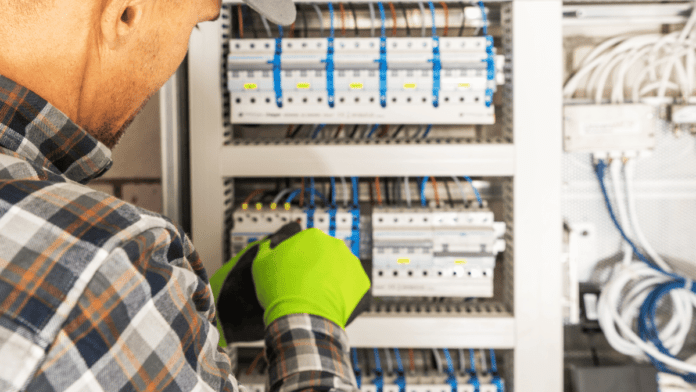Understanding the electrical breaker box in your home is a fundamental step toward ensuring safety, efficiency, and the smooth operation of your household appliances and electronics. This beginner’s guide aims to demystify the breaker box, offering homeowners the essential knowledge to navigate this critical component of their home’s electrical system.
From identifying a breaker box to guiding you through its essential maintenance, this article will cover everything you need to know to manage your home’s electrical power like a pro. To bring expert insight into our discussion, we’ve consulted with Damon Bernath, a master electrician based in Cincinnati, who offers professional advice on approaching your home’s electrical breaker box.
What is an Electrical Breaker Box?
At its core, the electrical breaker box is the nerve center of your home’s electrical system. It’s where the electrical power from the utility company enters your home and is distributed to the various circuits that power everything from light fixtures to outlets. The breaker box houses a series of switches, known as breakers, which control the flow of electricity to these circuits.
Each breaker is designed to “trip” or shut off automatically during an electrical overload or short circuit, preventing potential damage to your appliances or, more critically, averting fire hazards.
The Importance of Understanding Your Breaker Box
Knowledge of your breaker box can help in several situations, such as resetting the power after a trip, adding new electrical fixtures, or safely shutting off power to a circuit when making repairs or updates.
According to Damon Bernath, understanding your breaker box is about handling issues when they arise and preventative maintenance. “Regular checks can help identify potential problems before they escalate, ensuring the safety and efficiency of your home’s electrical system,” Bernath advises.
Identifying Your Breaker Box
Most homes have breaker boxes in the basement, garage, or outside walls. They’re typically metal boxes with a door that opens to reveal a row (or multiple rows) of switches. Each switch corresponds to a specific circuit in your home. You might also find a main breaker that controls the power supply to the entire house.
Navigating Your Breaker Box
Understanding how to navigate your breaker box involves knowing what each breaker controls. Labeling each breaker with the area of the home or specific appliances it powers can save time and confusion, especially in emergencies.
“Take the time to label each circuit in your breaker box accurately. It’s a simple step that can significantly enhance your safety and efficiency in managing electrical issues,” suggests Bernath.
Resetting a Tripped Breaker
One of the most common interactions with the breaker box is resetting a tripped breaker. A breaker trips as a safety measure to prevent overloading a circuit.
To reset, first, identify the tripped breaker, usually indicated by a switch in the “off” position or a middle position between “on” and “off.” Before resetting, unplug any appliances that might have caused the overload. Then, firmly push the breaker to the “off” position before flipping it back to the “on” position. This should restore power to the circuit.
When to Call a Professional
While having a basic understanding of your breaker box is essential, some situations require professional intervention. If you’re experiencing frequent trips, noticing a burning smell from the breaker box, or planning major electrical upgrades, it’s time to call a professional.
Damon Bernath emphasizes, “Working with electricity carries inherent risks. If you’re ever in doubt, it’s best to consult with a licensed electrician who can ensure the safety and compliance of your home’s electrical system.”
Regular Maintenance
Routine maintenance of your breaker box can prevent many common electrical problems. This includes ensuring the area around the breaker box is clear of obstructions, checking for signs of wear or damage, and periodically testing the functionality of each breaker.
Consulting with an electrician for a professional inspection every few years is also a prudent measure to ensure the longevity and safety of your home’s electrical system.
Final Thoughts
The electrical breaker box is a critical component of your home’s infrastructure. You can confidently manage your home’s electrical system with a basic understanding of its function, maintenance, and safety protocols. Remember, electricity is powerful and can be dangerous. While this guide offers a starting point, the wisdom of professionals like Damon Bernath is invaluable. When in doubt, always seek the expertise of a licensed electrician to handle complex issues or upgrades to your home’s electrical system.
This beginner’s guide is an empowering tool for homeowners, ensuring you’re equipped with the knowledge to manage your electrical breaker box safely and effectively. Whether resetting a tripped breaker, labeling circuits, or performing routine checks, a fundamental understanding of this system enhances your home’s safety and peace of mind.




